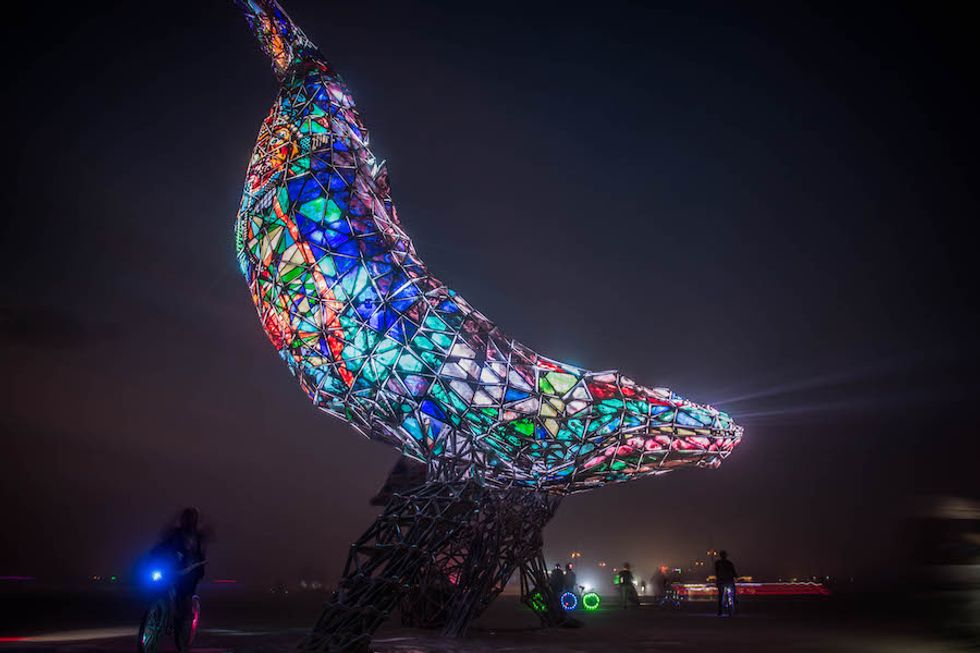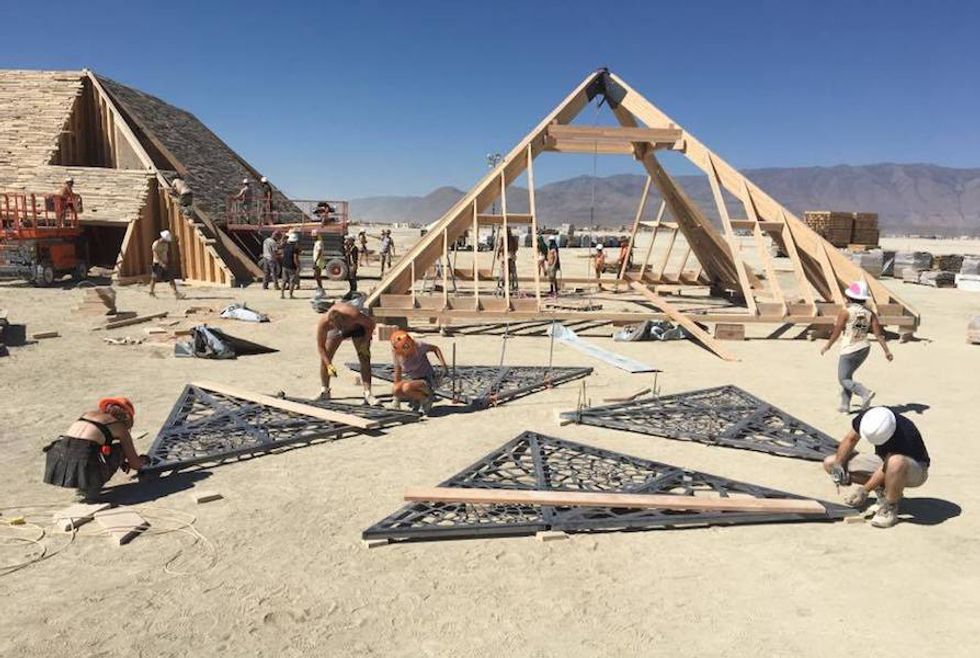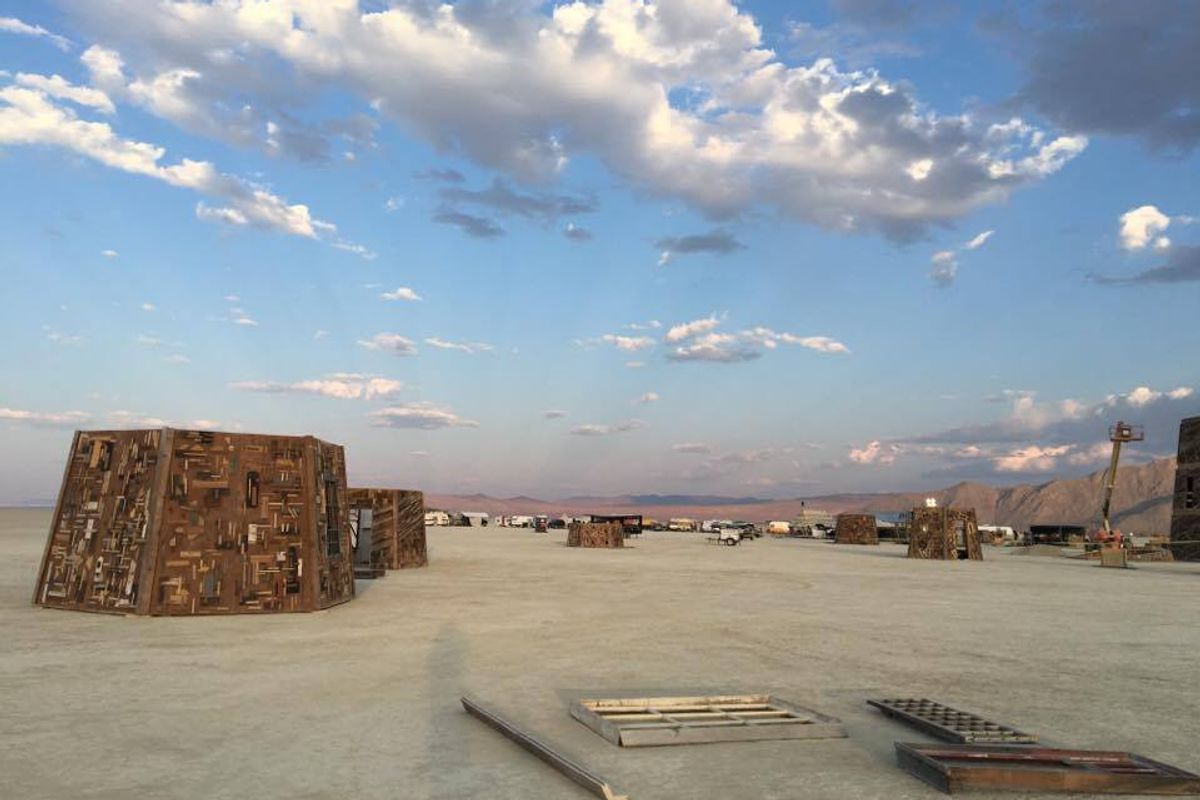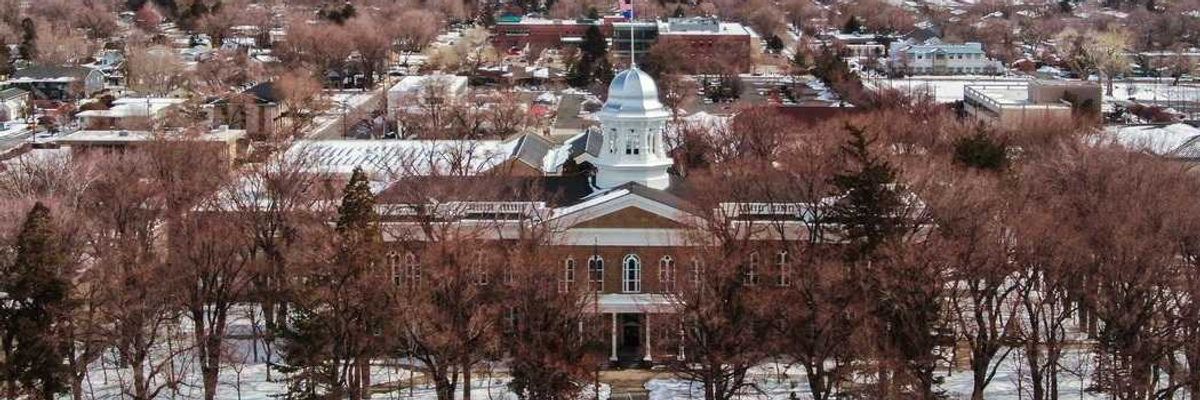A GPS leads a group of dusty shirtless men and women in steel-toed boots to a nondescript patch of Nevada desert. It's no different than the swath of sand to its left or to its right, until a spike is driven into the ground.
This cast of construction workers who look like characters from Mad Max are the volunteer desert dwellers and full-timer staff of the Department of Public Works (DPW). And this is Golden Spike Day, a celebratory and sacred day. The center has been chosen and Black Rock City will be planned and erected around it. As of July 31st, Burning Man officially began.
This year's throng of costumed and barely clad burners arrived in the desert this week—the annual event kicked off August 27th and runs through Labor Day weekend—and already pictures are circulating of the event's iconic larger-than-life installations—a gigantic takeout box with flame-throwing chopsticks is serving late-night dumplings to the hallucinating masses. But Burning Man, with permanent headquarters in San Francisco's Mission District and a full-time staff of 100 or so perfectly normal-looking professionals, is a year-round endeavor more on par with a large-scale corporation than the breathless art exhibition meets drug fest in the desert might suggest. In fact, Burning Man is one of the largest funders of individual art in the Bay Area. The New York Times called the festival "anarchy so well organized that there are registration forms, a media contact and a press kit."
What began in 1986, when founders Larry Harvey and Jerry James burned a wooden man on Baker Beach to celebrate the Summer Solstice with a few dozen of their hippie friends, is now an epic (or infamous, depending who you ask) gathering of 70,000ish partygoers who head to The Playa each year for a week of eye-popping everything. But for all its hedonism and image of spontaneity, Burning Man isn't much different from any other organization that puts on large-scale art fairs and theatrical productions. It has a CEO (a longtime burner and an Academy of Art University MFA-holder Marian Goodell) and a board of directors, a legal team and a communications director, not to mention a fairly corporate-looking website with articles on everything from what to wear to how to mentally prepare for the experience.
While the office types in the city are busy working to spread the Burning Man ethos around the world and raising money to then give as grants—all proceeds to Burning Man go to artists and affiliated events all over the globe—it's the unsung crew in the desert that makes the event function.
When Nathan Altman, 30, first arrived at the build site in 2015, he didn't even know the job was for Burning Man. A civil engineer with experience in architecture, Altman had never even been to Burning Man, but his skills served the immediate needs of Black Rock City and he was soon put in charge of building the main temple. Today, he is the full-time Man Pavilion Superintendent in charge of DPW.
While burners like to feel that they are conquering this remote and wild landscape, DPW spends the three weeks leading up to the event taming the expanse into a makeshift city. They survey the land, lay electrical cable, create plumbing, and mark streets. Last year, 200 shelters were erected to bring acres of shade to the desert city, the location of which is strategically rotated each year to avoid causing permanent damage to the terrain. By the second week of buildout, even the workers are half naked and covered in dust.
"A DPW season is intense." Altman says. "The remoteness is a big unifier. You might get to know someone better than if you worked five years with them at a regular job."
The extraordinary circumstances and requirement for precise skill sets makes for an exceptional group of contributors. The state inspector for all of Nevada's propane was tapped as the Director of Fuel. Plumbing was run by two Stanford PhDs, and a professional BMX rider comes each year just to drive a truck.

And then there are the artists who, if they're lucky enough to get a Burning Man grant (last year, the org awarded $1.2 million dollars for 316 installations), must often still raise additional funds to see their projects to fruition. Matt Schultz, a 38-year-old Reno-based artist who runs a collective called The Generator, has built three grant-funded projects at Burning Man. His first 2011's The Pier, was a 300-foot-long wooden dock decorated with 1,000 LED lights.
"Burning Man doesn't create more artistic freedom," he says. "It just gives you permission." The organization aims to supply the artists with all the resources they need once they arrive in the desert—heavy equipment, a metal shop, professional advice. Because artists are pushing the boundaries of what is possible in some of the hardest conditions imaginable, Burning Man tries to deliver the infrastructure that supports the artist's work.
During his time building at Burning Man, Schultz has even worried for his life. In 2015 while building the magnificent stained glass Space Whale, he got caught on top of a 50-foot crane as 25-mile-per-hour winds (and dust) kicked up. But the building went on.
"There is a reason people don't build the objects of their dreams," he says. "It's exhausting. You have to raise a huge amount of money. When you go to the hardware store, everyone gives you funny looks, and it's hard to ask people to do what is traditionally really hard work for no money and just for the fun of it," he adds, referring to the many volunteers that artists must recruit to help bring their creations to life.
Sam Costigan was a volunteer on 2016's Catacomb of Veils, a pair of wooden pyramids that covered almost 19,000 square feet of sand, each draped on the inside with silken curtains. Costigan worked many a weekend before finally heading out to The Playa two weeks before the event. Construction went on all day, with temperatures well into the 100s by day and dipping below freezing at night. As the big day neared, work continued deep into the night, with massive floodlights fighting against the desert blackness. All this, to see the works essentially destroyed ("We build it to accommodate the dumbest people in the world climbing on it," says Schultz), and ultimately set on fire.
Participating in the build changed Costigan's experience of the event itself, opening his eyes to the massive amount of time and energy it takes to create the city. Many thanked him for his contribution.
"I had never thought to thank anyone for what they brought before," Costigan says. "Now when I'm out [in the city], I try to do that."

Everyone at Burning Man participates—it's one of the 10 principles that act as the event's golden rules. (The ones who don't are dubbed "Sparkly Ponies"—just there to look pretty.) But while most are thinking about where they can trade their MDMA for pancakes or score a dust-free space to lounge, they may be overlooking the rangers, those critical volunteers who mercifully take the place of cops (who are only called in for very serious matters). A four-time ranger who goes by the name Fortress on the Playa is just one of 800 volunteer rangers from around the world.
"We don't have any set authority," Fortress explains. "The only way to contribute is based on our social capital and how we are perceived."
Rangers are equal parts safety officer, therapist, tour guide and EMT—they help burners navigate the city and the experience. They can't kick people out. They can't arrest or confiscate anything (and, more importantly, they don't want to). They are burners themselves who seek to protect the the magic that happens inside the fence surrounding Black Rock City.
"We are not here to stop people from being stupid," Fortress says. "And we are not here to protect property." For a ranger, a successful shift is a boring one.
In total, about 2,000 people volunteer before, during and after Burning Man, making art cars (last year there 624), serving meals, acting as rangers, and throwing parties at one of several hundred themed camps. For them, working the event is the experience.
"We are so hard-wired that everything must be extrinsically motivated," says Schultz. "At Burning Man, we just skip the middleman. You don't need a financial transaction to find joy." // burningman.org
This article was originally published in August 2017. Burning Man 2018 takes place August 26 through September 4.





















